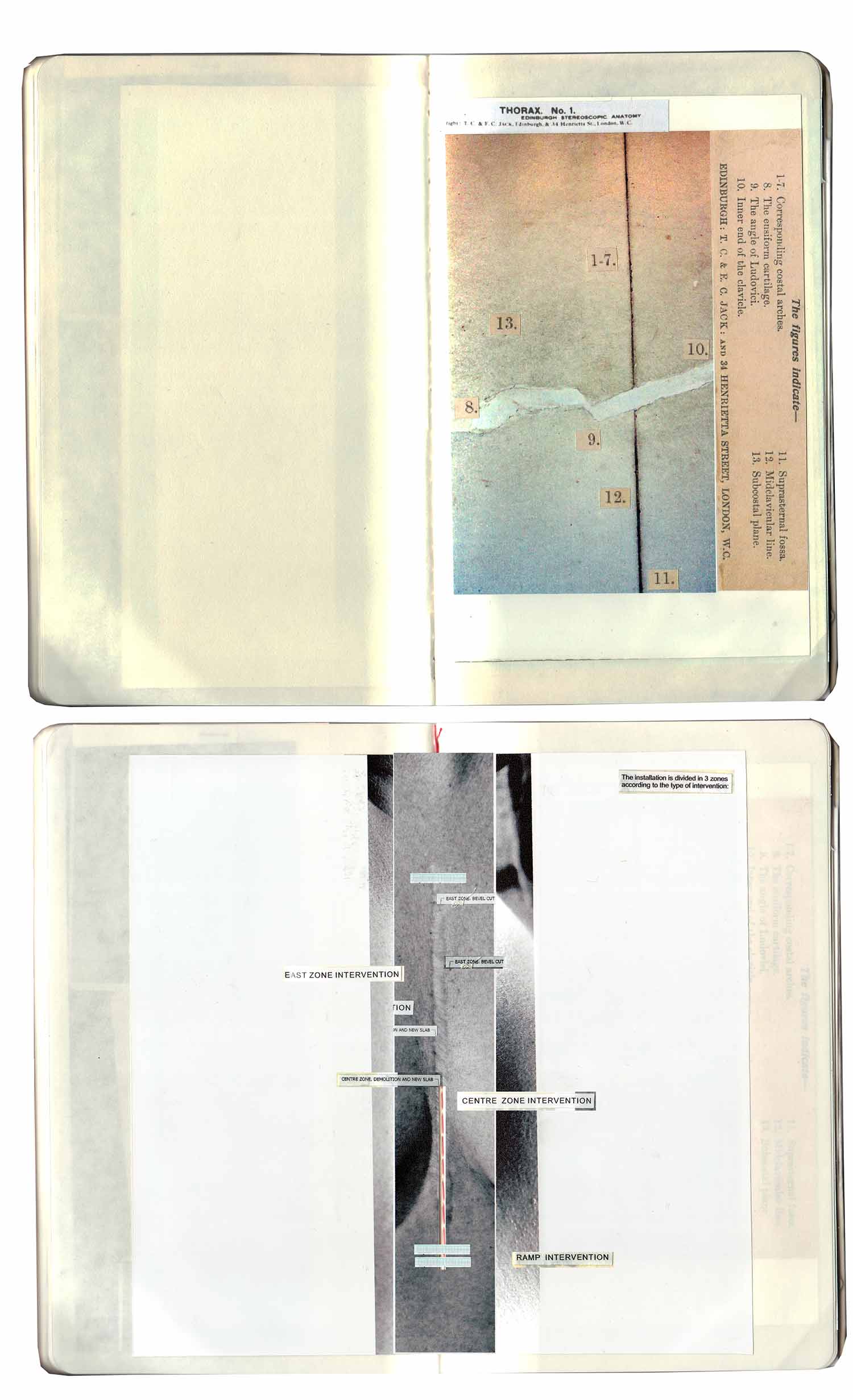
Remember, repeat, work-through. Sigmund Freud.
One Wound, Two Wounds is a site-writing project though which I explore and ‘work-through’ my encounter with Doris Salcedo’s Shibboleth (2007), an art installation that more than ten years ago disturbed the smooth concrete slab of the Tate Modern’s Turbine Hall and that today still inhabits it, though quietly, closed and sealed; present as a still and timeless reminder.
As a site-writing project, One Wound, Two Wounds proposes to look at the question of the body and the building as sites for writing. It is an exploration of the body (my own body), in relation to building (the Tate), and to a sculptoral trace (that of Doris Salcedo’s Shibboleth (2007) Tata Modern, London) through a combination of texts, photographs, photo-montages, collages, and through the use of traditional and material tools of architectural investigation – scale, form, material, site. A red sketchbook acts as the place that provides these encounters: the material collected in its pages evidence the free-association process that led the initial deconstruction of Shibboleth through drawing, pasting, cutting, writing and redrawing to become a process of deconstruction of the scar in my chest, of my past, of my condition as immigrant.
One Wound, Two Wounds offers a re-interpratation of ‘site’, ‘self’and ‘space’ as they relate; suggesting new and unexpected relationships between them. It is a process of understanding London-Colombia, past-present, illness-health, identity-language, belonging-removal, proximity-emoteness, coloniality-postcoloniality-decoloniality, subjectivity-distance: parts of my present and past that I have not been able to uncover. One Wound, Two Wounds was conceived, and is still today, an ongoing healing process
Catalina Mejía Moreno is an architect and architectural humanities researcher formed in Colombia and the UK based at the University of Brighton as Senior Lecturer in where she teaches Architectural Humanities in all undergraduate years as well as in the Masters in Architecture. She holds a BA from the Universidad de los Andes in Bogotá (2003), an MA in Architectural History from the Bartlett School of Architecture, UCL (2010) and a PhD in Architectural Theory and Criticism from Newcastle University (2019) with the thesis ‘Returns – Towards a Photographic Criticism’ [Or, the case of the North and South American elevators and the Berliner Bild Bericht] where she explores the ‘photographic canon’ as an architectural phenomena in itself, and suggests material practices to destabilise and subvert its normalization.
Her research on photography and architecture has been funded by the DAAD and the Getty Research Institute. She was also an Andrew Mellon Fellow at the CCA in Montreal for the multidisciplinary research project Architecture and/for Photography (2016-7) where she explored performative ways of working with historical and archival material through site-specific projection and re-enactment. She is a member of editorial boards of Dearquitectura journal and of a forthcoming Birkhaüser book series; and the co-founder with Dr. Anne Hultzsch of the EAHN Interest Group Building Word and Image where she also explores questions of representation in its wider meaning.
Her more recent work explores ways of destabilizing canonical constructs as well as critical ways of decolonizing and re-energising architectural history and theory teaching through feminist and de-colonial theory and tactics and as informed by her background, her adjunct faculty position at the Universidad de los Andes (Bogotá, Colombia) as well as by her own teaching practice. This is also being done in collaboration with Emma Chealte and through OtherWise, our collaborative practice.
For some time, and more present in my recent work, I have adopted a mode of working which I frame as ‘working differently,’ and that draws upon Luce Irigaray’s, Hélène Cixous, and Rosi Braidotti’s ‘difference,’ Taking Place’s practising ‘differently,’ and Griselda Pollock’s ‘differencing.’ It is a working method that aims towards making visible power structures and normalised constructs, in order to raise awareness of their existence, their role in architecture and architectural culture more broadly speaking, but also of their partial nature. Doing it ‘differently’ is therefore a means to interrupt and disrupt them, to destabilise their normalisation, and to relate the ‘doing’ to the subjectivity of the tutor/student/researcher/artist through site-specific practices that can be material, performative, written etc.
Katie Lloyd Thomas, ‘Building while being in it: notes on drawing ‘otherhow’’ in Doina Petrescu, (ed.) Altering Practices: Feminist Politics and Poetics of Space (Abingdon: Routledge, 2007), pp. 89-112.
Audre Lorde. ‘The transformation of Silence into Language and Action’ in Audre Lorde, Sister Outsider: essays and speeches, (Crossing Press, 1984).
María Lugones, ‘Towards a Decolonial Feminism,’ Hypatia, v. 5, n. 4. (Fall 2010) pp. 742-759.






































































